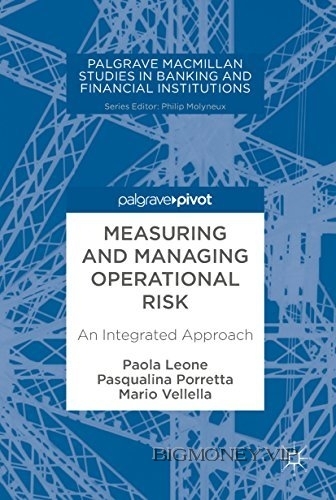
1. Introduction to the Work and
Operational Risk
Paola Leone and Pasqualina Porretta
Sapienza University of Rome, Rome, Italy
Paola Leone (Corresponding author)
Email: paola.leone@uniroma1.it
Pasqualina Porretta
Email: pasqualina.porretta@uniroma1.it
Abstract
This chapter describes the integrated risk approach used by the Authors for
operational risk measurement and management, and presents a logic
scheme to help readers better understand the different elements of
Operational Risk Management (ORM). It also describes the evolutionary
process of the definition of operational risk, its main features and various
dimensions.
Keywords Operational risk – Operational risk losses – Integrated risk
management
Although the chapter has been prepared by both authors jointly, §§ 1.1, 1.2
was written by Paola Leone, whereas §§ 1.3, 1.4 by Pasqualina Porretta.
1.1 Introduction
Operational Risk Management (ORM) is playing a new role in the field of
Risk Management, as it has undergone a radical change. Indeed, the only
regulatory definition of operational risk has experienced a major evolution.
In fact, in the Basel Committee’s early work (BCBS 1998) it had a
“negative” meaning, as operational risk was everything that did not fall
within the better known and classified categories of credit risk and market
risk. Subsequently, the BCBS developed a “positive” notion (BCBS 2001a)
defining operational risk as “the risk of direct or indirect loss resulting
from inadequate internal processes, human errors, system failures or related
causes. Strategic and reputational risk is not included in this definition for
the purpose of a minimum regulatory operational risk capital charge. This
definition focuses on the causes of operational risk and the Committee
believes that this is appropriate for both risk management and, ultimately,
measurement”.
The concept of operational risk has been at the centre of increasing
debate also in the ORM literature over the years (see for example,
Klugman, S. A. et al. (1998); King J. L. (2001); Cruz M. G. (2002);
Cruz M. (2003a, b); Chapelle et al. (2004); Giudici P. (2004); Giudici P.,
Stinco G. (2004); Moscadelli M. (2005, 2005b); Cosma S. (2006,
2014); Moosa (2007a, 2007b, 2007c); Birindelli G., Ferretti P. (2009,
2017); Girling P. X. (2013); Cruz et al. (2015); Franzetti C. (2016); Robertson D. (2016)).
In the current market, Authorities have emphasized the importance to
find an “internal” definition of operational risk, integrated in the bank’s
specific business and typical operational losses of its production process.
Moreover, Authorities and the Basel Committee’s Task Force have
expanded the set of information on AMA methodologies (qualitative and
quantitative requirements) regarding procedures for estimating distributions
(frequency and severity). However, the efficiency of the measures on
operational losses is directly related to loss data collection and, therefore, to
the quality of the data available. In this perspective, one of the most critical
aspects of Operational Risk Management is the measurement or quantitative
assessment of operational risk. As known, the Loss Distribution Approach
(LDA) is the most popular method for calculating capital charges starting




